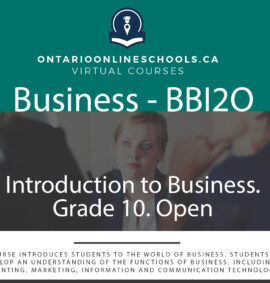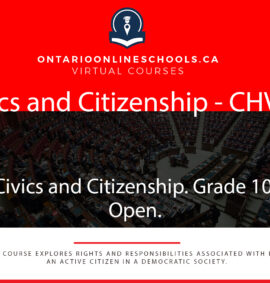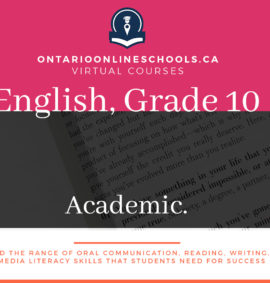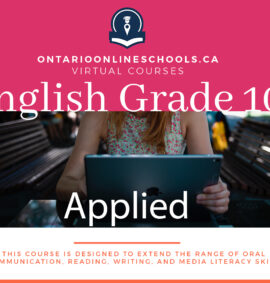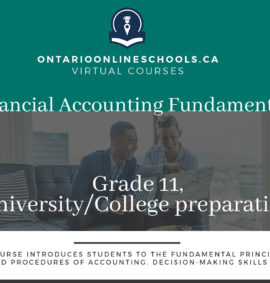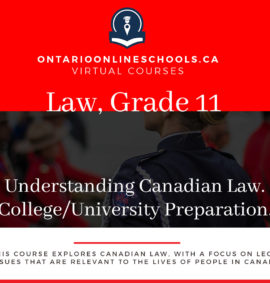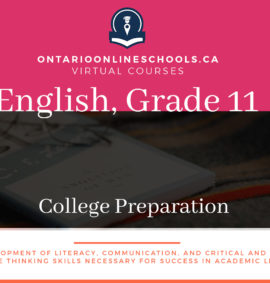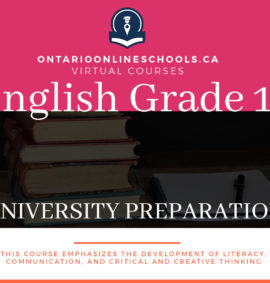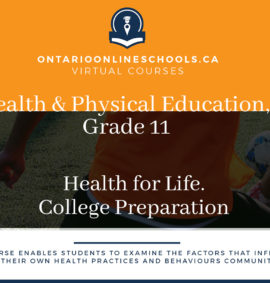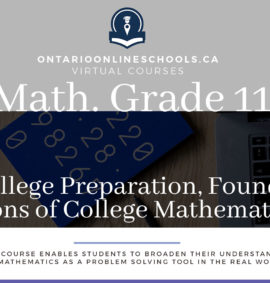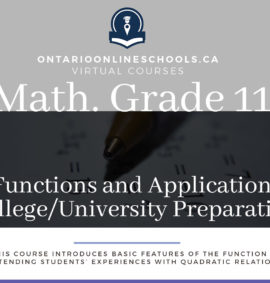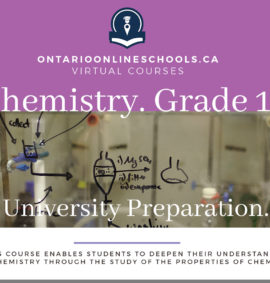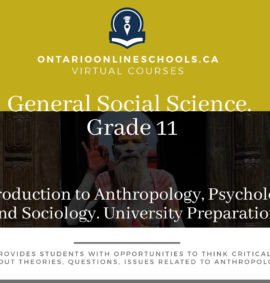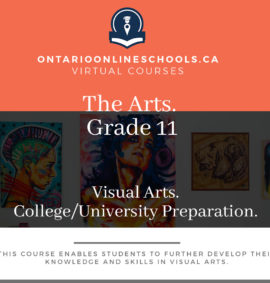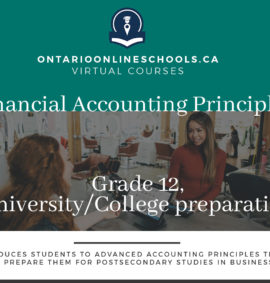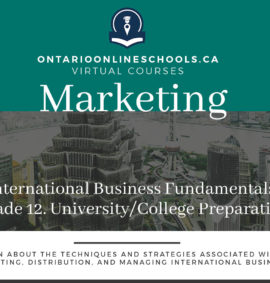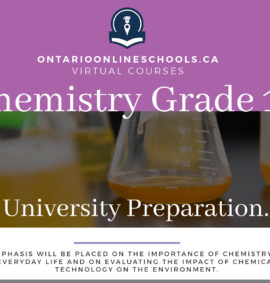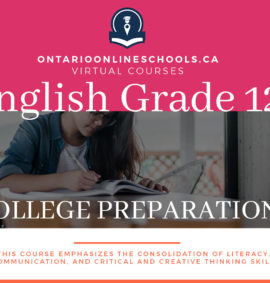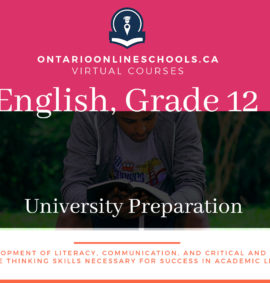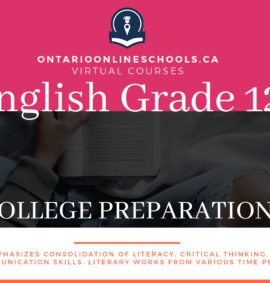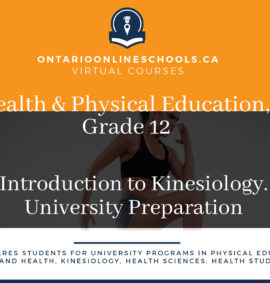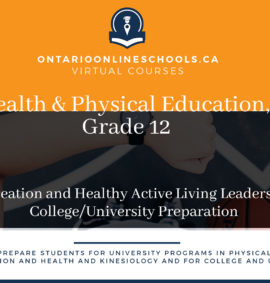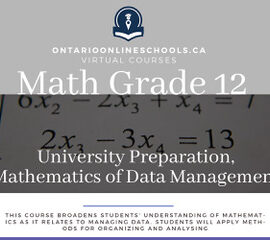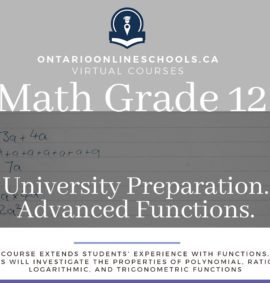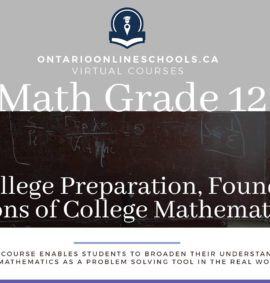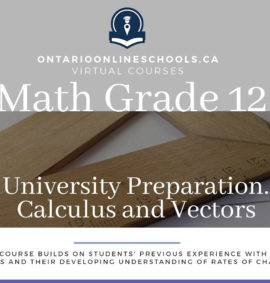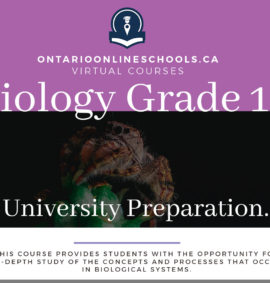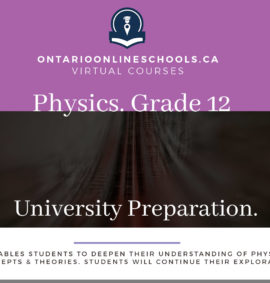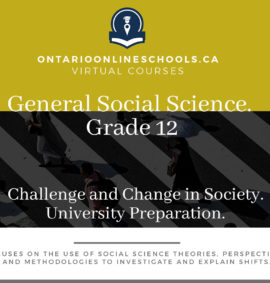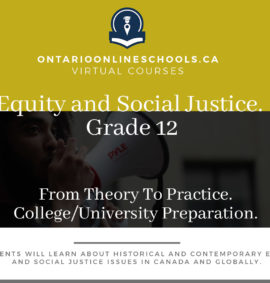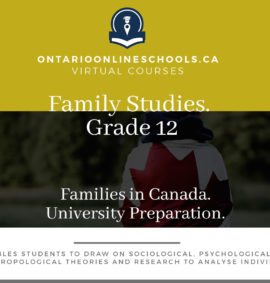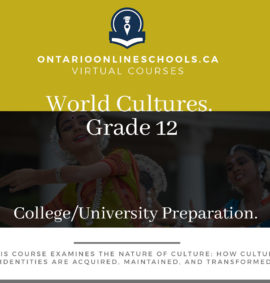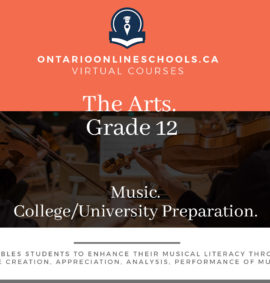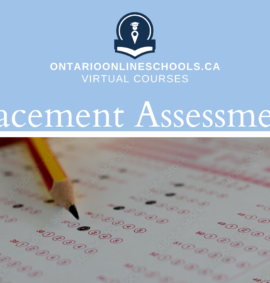Section 1 – School Policies, Practices, and Procedures
1.1: The Importance of completing a secondary education.
The importance and value of completing a secondary education cannot be overstated. The OOS was created by currently practicing frontline educators who know first-hand, the importance of earning an OSSD. We are committed to creating, maintaining, and where needed, modifying online courses that can help each student achieve a successful outcome from their secondary school experience.
1.2: The requirement to remain in secondary school
Every student in Ontario is required to remain in secondary school until they reach the age of eighteen, or obtain the Ontario Secondary School Diploma (OSSD). OSS aims to provide each student with the opportunity to achieve academic success; however the student chooses to define “success”. The courses offered at OSS can help students pursue academic interests that may not be offered at their regular day school. As well, our learning platform is used by many post-secondary educational institutions, as well as in the public and private sector, for staff professional development. Thus, taking high school courses at OSS will prepare students for online learning later in life.
1.3: The School’s Overall Philosophy
Our overarching goal at OOS is to provide each student an online learning experience that properly prepares them for whichever post-secondary path they choose to pursue. We aim to achieve this by providing an inclusive, engaging, challenging, and collaborative online learning environment.
Every decision we have made, from the choice of Online Learning Platform (OLP), to the content of every course, to the selection of teachers, has been made with students in mind. As currently practicing teachers and parents of children currently in the education system, we have taken an In Loco Parentis philosophical approach, and created an online school that we would be comfortable sending our own children to, and recommending to our family, friends, neighbors, and colleagues.
1.4: The school’s organization
Although we are a school that only exists in the digital realm, the OOS is structured like a regular school: we have a Principals Qualification Course Principal, a guidance counselor, OCT certified and teachers. For more information about the REAL PEOPLE behind The OOS, please see the About Us Section of the main website
All OSS courses are fully online, asynchronous courses that are designed to require at least 110 hours. The OSS school year currently has 3 parts:
- The fall semester starting in the second week of September, and running for approximately 20 weeks;
- The spring Semester starting in the second week of February, and running for approximately 20 weeks;
- The summer semester, starting in the first week of July, and running approximately 6 weeks.
All OSS reporting of student achievement is grounded in Growing Success (2016). All OSS courses will feature four (4) reporting periods:
- The first will happen within the first 4 weeks, and will focus on reporting on the student’s learning skills, as they relate to success in an online learning environment.
- The second will happen between the 12th and 13th week of the course, and will feature reporting on the student’s achievement level, learning skills, and individualized comments about the student’s achievement of curriculum expectations.
- The third will happen between week 17 and 18, and will focus on student achievement on the 70% of the course’s term work.
- The fourth will happen after week 20, and will feature reporting on the student’s overall learning skills, comments about the student’s achievement of curriculum expectations, as well as a final percentage grade.
All OOS students’ learning skills will be evaluated according to the guidelines found in Growing Success:
OSS report cards are issued on official Secondary provincial final report cards for semester schools
The final timetables for all courses at The OOS are co-created by the students and the teacher, around the school wide reporting periods.
1.5: The OOS’ Attendance Policy
For information about The OOS’ expectations regarding student responsibilities, achievement, and attendance, please sees The Assessment and Evaluation and Reporting manual on the main page.
Success in an online learning environment depends on regular and active participation in class activities. As a rule of thumb, it is recommended that students spend approximately 10 hours a week on the course. This includes time logged on to the OLP, as well as off line time working on lesson materials. Students are expected to log on to The OOS Learning platform at least once a day, and MUST log on at once every 3 days, unless prior arrangements have been made with your teacher. The school will try to contact the student, and their parents and guardians by telephone (if the student is under 18 years of age), if the student’s attendance is not meeting The OOS’ expectations.
Failure to log onto the OLP frequently or to participate in class activities may result in consequences up to and including lost marks, assigning zeros, or removal from the course, as the situation may warrant. For a more detailed description of The OOS attendance and work submission policy, please see the Assessment and Evaluation manual.
1.6: The school’s code of conduct, and safe school policy
The OOS is pleased to provide a safe and inclusive learning environment for all our students and educators. The integrity of all people involved in The OSS is paramount, and indignities to this integrity will not be tolerated. Informed by the Education Act, the Ontario Code of conduct, the Ontario Human Rights Code, The OOS code of conduct can be summarized in one sentence:
If You Wouldn’t Say It In Person, Or Do It Face To Face In A Traditional Classroom, Then Don’t Say or Do It In The Virtual Classroom.
For more detailed information, please see the Assessment and Evaluation Reporting Manual
Section 2 – Diplomas and Certificates
2.1: Compulsory Credit Requirements
Students interested in earning the OSSD (Ontario Secondary School Diploma) must successfully complete a total of 30 credits; of which 18 are prescribed and 12 credits are optional.
In addition, students must also complete 40 hours of Community Involvement Activities and must meet the provincial literacy requirement.
The Compulsory Credits are:
- 4 credits in English (1 credit per grade) *
- 3 credits in mathematics (1 credit in Grade 11 or 12)
- 2 credits in science
- 1 credit in Canadian history
- 1 credit in Canadian geography
- 1 credit in the arts
- 1 credit in health and physical education
- 1 credit in French as a second language
- 0.5 credit in career studies
- 0.5 credit in civics
Plus one credit from each of the following groups:
1 additional credit (group 1): additional credit in English, or French as a second language, or a Native language, or a classical or an international language, or social sciences and the humanities, or Canadian and world studies, or guidance and career education, or cooperative education
1 additional credit (group 2): additional credit in health and physical education, or the arts, or business studies, or French as a second language, or cooperative education
1 additional credit (group 3): additional credit in science (Grade 11 or 12), or technological education, or French as a second language, or computer studies, or cooperative education
2.2: Optional Credit Requirements
In addition to the 18 compulsory credits described above, students must also complete an additional 12 Optional Credits.
2.3: The Ontario Secondary School Literacy Requirements
In order to be granted an Ontario Secondary School Diploma (OSSD), students must take and pass the Ontario Secondary School Literacy Test (OSSLT).
- Students working towards the OSSD must complete the OSSD Literacy requirement.
- The Ontario Secondary School Literacy Course may be offered by private schools through online learning. The same eligibility requirements for this course will continue to apply.
- The requirements for earning an Ontario Secondary School Diploma (OSSD) include the requirement that all students must meet the secondary school literacy requirement
- The Ontario Secondary School Literacy Test (OSSLT) is the usual method for assessing the literacy skills of students in Ontario for the purpose of determining whether they meet the provincial secondary school literacy requirement for graduation.
- Where the student has not been successful in the OSSLT, the school establishes a procedure for offering the Ontario Secondary School Literacy Course (OSSLC).
- Mature students have the option to enrol directly in the Ontario Secondary school Literacy Course without first attempting the OSSLT. They may still elect to meet the literacy graduation requirement by successfully completing the OSSLT. A mature student is a student who is at least eighteen years of age on or before December 31 of the school year in which he or she registers in an Ontario secondary school program; who was not enrolled as a regular day school student for a period of at least one school year immediately preceding his or her registration in a secondary school program (for mature students, a school year is a period of no less than ten consecutive months immediately preceding the student’s return to school); and who is enrolled in a secondary program for the purpose of obtaining an OSSD.
- The Literacy Requirement is the responsibility of the school that holds the student’s OSR.
Students will have to make arrangements to complete this requirement of the OSSD graduation, as OOS do not administer the OSSLT, or offer the OLC4O course.
2.4: The Community Involvement Requirements
As stated in the Ontario Secondary Schools, Grades 9 to 12: Program and Diploma Requirements, 1999 (OSS), every student who begins secondary school during or after the 1999–2000 school year must complete a minimum of 40 hours of community involvement activities as part of the requirements for an Ontario Secondary School Diploma (OSSD). The purpose of the community involvement requirement is to encourage students to develop awareness and understanding of civic responsibility, of the role they can play, and the contributions they can make in supporting and strengthening their communities.
Responsibilities of School Boards
As stated in OSS, community involvement activities may take place in a variety of settings, including businesses, not-for-profit organizations, public sector institutions (including hospitals), and informal settings. Each school board is responsible for developing a list of community involvement activities that the board considers acceptable. The board’s list must not include activities that are designated as ineligible in this memorandum. The board must develop its list of approved activities in consultation with the school councils of schools in its jurisdiction, the Special Education Advisory Committee, and the board’s insurer. It should be noted that students will not be paid for performing any community involvement activity.
School boards will develop the forms on which students list (a) their planned activities and (b) their completed activities. A sample of each form is included in the Appendix to this memorandum. The “Notification of Planned Community Involvement Activities” form must include at least the information on the sample form. The “Completion of Community Involvement Activities” form must also include at least the information on the sample form.
Boards must also develop a document that explains the community involvement requirement and the roles and responsibilities of the various participants. A sample document, entitled “Information on the Community Involvement Diploma Requirement”, is provided in the Appendix to this memorandum. The board’s document must contain at least the information given in the sample document. It must include an overview of the requirement and the roles and responsibilities of the student, parents,(2) and person or organization sponsoring an activity. It must also provide the list of activities approved by the board, as well as the ineligible activities. This document will be given by students to their parents and to the person supervising their community involvement activity.
Any training, equipment, or special preparation that is required for an activity should be provided by the person or organization sponsoring the activity. Each board must ensure that all participants, including students and the sponsors of community involvement activities, are adequately covered by the board’s insurance.
School boards must ensure that they collect and store personal information in accordance with the Municipal Freedom of Information and Protection of Privacy Act.
Responsibilities of the Principal
The principal will ensure that a description of the community involvement requirement and an outline of the policies on and procedures for completing the requirement are included in the school course calendar. He or she will also ensure that students are provided with the information and forms needed to complete the community involvement requirement, including information about the activities that are approved by the board and the activities that are ineligible, as well as copies of the board’s information document that are to be given to the parents and to the person supervising the community involvement activity.
If a student proposes to undertake an activity that is not on the board’s list of approved activities, the principal will determine whether the student’s proposed activity is acceptable, in consultation with the appropriate supervisory officer. If the activity is acceptable, the principal must keep a copy of the approval on file. (The principal is not required to give approval of activities that are on the board’s list of approved activities.)
The principal will determine whether the student has met the community involvement requirement, and, if so, will indicate on the Ontario Student Transcript that the student has completed the requirement.
Procedures for Students
Students may complete the 40 hours of community involvement activities at any time during their secondary school program. They may also complete any number of activities, as long as those activities result in the completion of 40 hours of community involvement. Students under the age of eighteen years will plan and select their community involvement activities in consultation with their parents.
Before beginning any community involvement activity, each student must complete and submit a “Notification of Planned Community Involvement Activities” form. The student will select an activity (or activities) from the board’s list of approved activities, or an activity that is not on the list, provided that it is not an activity that is on the ministry’s or board’s list of ineligible activities (see “Ineligible Activities” below). If the activity is not on the board’s list of approved activities, the student will have to obtain written approval from the principal (that is, the principal’s signature beside the activity described on the notification form). A student under the age of eighteen must complete the form in consultation with his or her parents, and must also have one parent sign the form. The student will sign the form and submit it to the principal or to another school contact designated by the principal (for example, the student’s teacher-adviser). More than one such form may be submitted when additional activities are planned that were not included on a previously submitted form.
When the activity is completed, the student must fill out the “Completion of Community Involvement Activities” form. The sponsor of the activity – that is, the person or organization that provided the community involvement activity – will complete the appropriate sections of the form to verify that the activity has been completed, and will sign the form. The form must also be signed by one of the student’s parents if the student is under eighteen years of age. The student must submit the form to the principal or other school contact upon completion of the 40 hours, or at appropriate intervals determined by the principal.
Students will provide their parents with a copy of the board’s document “Information on the Community Involvement Diploma Requirement”, which they will be given by the school. Students will also give a copy of this document to the sponsor of the community involvement activity.
Ineligible Activities
The ministry has developed a list of activities that may not be chosen as community involvement activities. These are referred to as ineligible activities. An ineligible activity is an activity that:
- is a requirement of a class or course in which the student is enrolled (e.g., cooperative education portion of a course, job shadowing, work experience);
- takes place during the time allotted for the instructional program on a school day. However, an activity that takes place during the student’s lunch breaks or “spare” periods is permissible;
- takes place in a logging or mining environment, if the student is under sixteen years of age;
- takes place in a factory, if the student is under fifteen years of age;
- takes place in a workplace other than a factory, if the student is under fourteen years of age and is not accompanied by an adult;
- would normally be performed for wages by a person in the workplace;
- involves the operation of a vehicle, power tools, or scaffolding;
- involves the administration of any type or form of medication or medical procedure to other persons;
- involves handling of substances classed as “designated substances” under the Occupational Health and Safety Act;
- requires the knowledge of a tradesperson whose trade is regulated by the provincial government;
- involves banking or the handling of securities, or the handling of jewellery, works of art, antiques, or other valuables;
- consists of duties normally performed in the home (i.e., daily chores) or personal recreational activities;
- involves activities for a court-ordered program (e.g., community-service program for young offenders, probationary program).
Students will have to make arrangements to complete this requirement of the OSSD graduation, as OOS do not administrate the Community Involvement Requirement.
2.5: Substitution Policy for Compulsory Credit Requirements]
In order to provide the flexibility to tailor an individual student’s program to the student’s needs and to support his or her progress through secondary school, principals may substitute up to three compulsory credits with courses from other subject areas specified in the list of compulsory credit requirements (including Groups 1, 2 and 3) outlined in section 6.1.1.
- The decision to substitute one course for another for a student should be made only if the student’s educational interests are best served by such a substitution (OS K-12 6.2). Substitutions are made to meet individual students’ needs.
- Substitutions should be made to promote and enhance student learning or to respond to special needs and interests.
- Students who have taken Native Languages in place of French as a second language in elementary school may use a Level 1 or 2 Native language course to meet the compulsory credit requirement for French as second language.
- Credits earned for co-operative education courses may not be used through substitution to meet compulsory credit requirements.
- If a parent or an adult student (a student who is eighteen years of age or older) requests a substitution for a compulsory credit, the principal will determine whether the substitution should be made.
- A principal may initiate consideration of whether a substitution should be made. The decision is made in consultation with the parent or adult student and appropriate school staff.
- English as a second language and English literacy development courses may not be used to substitute for a compulsory credit (they may be used, however, to meet the compulsory credit requirements for three English credits in accordance with section 6.1.1.
- No more than one learning strategy course, from the guidance and career education curriculum policy document may be used through substitution to meet a compulsory credit requirement.
- Credits earned for cooperative education courses may not be used through substitution to meet compulsory credit requirements.
- A Locally Developed Compulsory Credit (LDCC) course may not be used as a substitute for a compulsory credit; it may be used only to meet the compulsory credit requirement that it has been designed to meet (OS K-12 7.3.1)
- Each substitution will be noted on the student’s OST. Courses that meet the compulsory credit requirement are listed in OS K-12 6.1. Section 6.1 OS K-12 lists OSSD compulsory and optional course requirements.
Evidence:
School retains documentation confirming that the principal made the decision about a substitution in consultation with the parent or adult student.
Substitutions are noted on the OST.
The OOS will not make substitutions for compulsory or optional courses; students are expected to complete all compulsory and optional courses as outlined in the Ministry of Educations OSSD graduation requirements
2.6: The Requirements for the Ontario Secondary school Certificate
The Ontario Secondary School Certificate will be granted on request to students who leave school before earning the Ontario Secondary School Diploma, provided that they have earned a minimum of 14 credits distributed as follows:
Compulsory credits (total of 7)
- 2 credits in English
- 1 credit in Canadian geography or
- Canadian history
- 1 credit in mathematics
- 1 credit in science
- 1 credit in health and physical education
- 1 credit in the arts or technological education
Optional credits (total of 7)
7 credits selected by the student from available courses. The provisions for making substitutions for compulsory credits (described in section 3.2: Substitutions for Compulsory Courses) also apply to the Ontario Secondary School Certificate.
Students will have to make arrangements to complete this requirement, as the OOS does not issue Ontario Secondary School Certificates.
2.7: The Certificate of Accomplishment
Students who leave school before fulfilling the requirements for the Ontario Secondary School Diploma or the Ontario Secondary School Certificate may be granted a Certificate of Accomplishment. The Certificate of Accomplishment may be a useful means of recognizing achievement for students who plan to take certain vocational programs or other kinds of further training, or who plan to find employment after leaving school. The Certificate of Accomplishment will be accompanied by the student’s Ontario Student Transcript. For those students who have an IEP, a copy of the IEP may be included.
Students who return to school to complete additional credit and non-credit courses will have their transcript updated accordingly, but will not be issued a new Certificate of Accomplishment. The Ontario Secondary School Diploma or Ontario Secondary School Certificate will be granted when a student has fulfilled the appropriate requirements.
Students will have to make arrangements to complete this requirement, as the OOS does not issue Ontario Secondary School Certificates of Accomplishment.
Section 3: The Ontario Online School Curriculum
3.1: The Definition of a Credit
A credit is granted in recognition of the successful completion of a course which has been developed from an Ontario Ministry of Education guideline, and for which a minimum of 110 hours of instructional time has been scheduled. The credit is granted by the Principal of a school offering secondary school programs on behalf of the Ontario Ministry of Education. The Ontario Online School offers ministry Credits.
3.2: Definitions of the types of courses available in the Ontario Curriculum
Definition of Types of Courses
Students in Grades 9 & 10 will take their core courses (English, Mathematics, Science, French, Geography and History) in one of three levels – applied, academic. All elective courses will be taken at the open level.
Academic Level: “D”
Academic courses focus on the essential concepts of the discipline plus additional related concepts. Academic courses develop students’ knowledge and skills by emphasizing theoretical, abstract applications of the essential concepts while incorporating practical applications, as appropriate.
Applied Level: “P”
Applied courses focus on the essential concepts of the discipline. Applied courses develop students’ knowledge and skills by emphasizing practical, concrete applications of the essential concepts while incorporating theoretical applications, as appropriate.
Locally Developed Level: “L”
Locally Developed courses focus on the most essential concepts of a discipline. These courses are offered in Mathematics, Science, English and Canadian History. These courses will provide support for students making the transition to high school by enhancing their skills to allow them to be successful at secondary school.
Open Courses: “O”
Open level courses have one set of expectations for each subject and are appropriate for all students. Open level courses are offered for all non-core subjects and do not have a prescribed post-secondary destination.
Course Level Description for Grade 11 and 12 Courses:
Courses in grades 11 and 12 are offered in levels that are related to a student’s destination after high school – workplace, apprenticeships, college or university. Some courses are offered at the Open level. Most courses are offered at one other following five levels:
University/College Courses: “M”
Courses designed to prepare students for entrance to college and university programs following high school.
College Courses: “C”
Courses designed to prepare students for entrance to college programs following high school.
Workplace Courses: “E”
Courses designed for students planning to enter the workplace directly following high school.
Open Courses: “O”
Courses that are not specific to any particular post-secondary destination are appropriate for all students, and which students may take to meet compulsory or optional requirements.
University Courses: “U”
Courses designed to prepare students for entrance to university programs following high school.
Course Coding System: The design of the Ontario education system at the secondary level is framed on the concept of students earning credits, both mandatory and optional credits. The course coding of all programs offered through The OOS uses a 5-character system that is established and recognized by the Ministry of Education; for example:
Currently, The OOS only offers U, C, M, and O level courses in grade 11 and 12.
3.3: The Ontario Secondary School Course Coding System
The course coding of all programs offered through The OOS uses a five character system that is established and recognized by the Ministry of Education
If a Course has the code: M C V 4 U,
The first character indicates the major area of study for the course with M-mathematics, Science, E-English, and so forth.
The second and third characters serve as the course descriptor within the subject area, for example CV- calculus and vectors, BI-biology.
The forth character signifies the grade level; 1 is grade 9, 2 is grade 10, 3 is grade 11 and 4 is grade 12.
The fifth and final character is used to denote the intensity by which the course will be delivered.
In grade 9 & 10, options include D representing academic, P for applied and O for open level courses. In grade 11 & 12, this digit is geared towards the post-secondary destination: U is university, C is for college and M represents courses open to university or college.
Currently, The OOS only offers U, C, M and O level courses in grade 11 and 12.
3.4: Descriptions of the courses offered at The OOS
For a full list of courses offered at The OOS, please visit the Courses Offered Section on the main site.
3.5: Accessing Specific Course Outlines
All course outlines are posted in the classroom on the LMS, and are linked to in The Shop
3.6: Accessing Ontario Curriculum Policy Documents
The Ontario Online School offers courses developed according to the latest Ministry of Education requirements. For information on Ministry course documents and Ontario Curriculum Policy documents, please visit the Ontario Ministry of Education website.
3.7: Experiential Learning, Co-op Learning, and Job Shadowing
Cooperative education programs allow students to earn secondary school credits while completing a work placement in the community. These programs complement students’ academic programs and are valuable for all students, whatever their postsecondary destination. Cooperative education programs allow students to earn secondary school credits while completing a work placement in the community.
- A cooperative education program comprises, at a minimum, one cooperative education course and its related course, on which the cooperative education course is based.
- Any course from an Ontario curriculum policy document or any Ministry-approved locally developed course may serve as the related course for a cooperative education program.
- Students may earn a minimum of one and a maximum of two cooperative education credits for each related course
- If the related course is a multiple-credit course, a student may earn a maximum of two co-op credits for each credit earned in the related course.
- The cooperative education course consists of a classroom component and a placement component.
- A personalized placement learning plan (PPLP) must be developed for all students in a cooperative education program.
- A student’s progress in achieving the curriculum expectations and in meeting the requirements identified in the PPLP must be assessed and evaluated by a teacher through regular workplace monitoring meetings with the student and the student’s workplace supervisor.
Students will have to make alternative arrangements, because The OOS does not offer courses that have experiential learning, co-op, or job shadow components.
3.8: Withdrawing from a Course
While we hate to see students leave The OOS,
- any withdrawals from grade 11 and 12 courses made via email to guidance@ontarioonlineschools.ca email account within 48 hours (two days) of the issuing of the second report card (mid-course report card after) will result in the mark not being recorded on the Ontario Student Transcript.
- any withdrawals from grade 11 and 12 courses made via email to principal@ontarioonlineschools.ca email account within 120 hours (5 days) of the issuing of the second report card (mid-course report card after) will result in a “W” being entered in the “Credit” column of the OST along with the mark at the time of the withdrawal.
When students choose to withdraw from The OOS, refunds less finance charges, will be issued on a prorated basis until the issuing of the first report card, in week 4. After that, no refunds will be issued.
3.9: Changing Course Types
In Grades 10 to 12, a student may change to a different type of course in a given subject provided that the student has taken any course specified as a prerequisite for that course. If the student has not done so, he or she may take one of the specified prerequisite courses through summer school, night school, e-learning, the Independent Learning Centre, or independent study. If the principal believes that a student can be successful in a particular course without having taken the specified prerequisite course, the principal may waive the prerequisite.
While it is possible for students to change course types, all the courses offered at The OOS have specific prerequisites that must be completed before a student can take a course. In unique situations, please email guidance@ontarioonlineschools.ca to discuss changes in course types.
3.10: Prior Learning Assessment and Recognition of Course Equivalency
The PLAR process involves two components: challenge and equivalency. The challenge process is the process whereby students’ prior learning is assessed for the purpose of granting credit for a course developed from a provincial curriculum policy document. The PLAR challenge process is developed in accordance with Policy/Program Memorandum 129. (http://www.edu.gov.on.ca/extra/eng/ppm/129.html).
- Assessment instruments for the challenge process must include formal tests (70% of the final mark) and a variety of other assessment strategies appropriate to the particular course (30% of the final mark).
- A maximum of four credits may be granted through the challenge process for Grade 10, 11 and 12 courses.
- Full disclosure applies for Grade 11 and 12 PLAR for completed challenges.
- For students with credentials from other jurisdictions, the principal determines the total credit equivalency as well as the number of compulsory and optional credits still to be awarded in accordance with OS K-12
- Appendix 2 of OS K-12 provides a table to help principals determine the number of credits that incoming students must earn following any PLAR equivalency credits granted. For instance, a student transferring from home schooling, a non-inspected private school or a school outside Ontario must earn at a minimum an additional 4 credits, including 1 compulsory credit in English, mathematics or science.
- Students working towards the OSSD must complete the OSSD Literacy requirement.
- For students working towards the OSSD, the principal determines the number of hours of community involvement activities that students will have to complete. Policy/Program Memorandum No. 124A describes the requirements for community involvement.
Prior Learning Assessment and Recognition (PLAR) for Mature Students (OS K-12 7.2.5.2, PPM 132): EQUIVALENCY
- Because of the broader life experience of mature students, the requirements concerning the application of PLAR procedures are different for them than for regular day school students.
- A mature student is a student who is at least eighteen years of age on or before December 31 of the school year in which he or she registers in an Ontario secondary school program; who was not enrolled as a regular day school student for a period of at least one school year immediately preceding his or her registration in a secondary school program (for mature students, a school year is a period of no less than ten consecutive months immediately preceding the student’s return to school); and who is enrolled in a secondary program for the purpose of obtaining an OSSD.
Currently, the OOS does not conduct PLAR
3.11: Evaluation Policies
Students will be evaluated based on the overall expectations of the course through the achievement charts in the Provincial Curriculum Policy Documents for the courses in which they are enrolled. Evaluation is based on the level of achievement the student demonstrates in the skills and knowledge covered in a course. Seventy percent (70%) of the evaluation is based on daily classroom work and will be determined through a variety of methods, such as ongoing class demonstrations, observations, essays, conversations and class tests and quizzes. Teachers will use Assessment For and As learning practices to help students identify where they are, in relation to the learning goals and what next steps they need to take to achieve the goals. This ongoing feedback will help prepare students for Assessment Of Learning, which is the process of gathering and interpreting evidence of learning, for the purpose of summarizing learning at a given point in time, to make judgments about the quality of student learning on the basis of established criteria, and to assign a value to represent that quality. Thirty percent (30%) of the evaluation occurs at or near the end of the course and could include one or two or a variety of a portfolio, a presentation, a photo essay, a written essay, a series of journal entries, examination, and/or demonstration etc. This final evaluation allows the student the opportunity to demonstrate comprehensive achievement of the overall expectations of the course.
All OOS students’ learning skills will be evaluated according to the guidelines found in Growing Success:
OSS report cards are issued on official Secondary provincial final report cards for semester schools
.
For more detail on The OOS Assessment and Evaluation policies, please see the Assessment and Evaluations Section.
3.12: Examination Policies
Thirty percent (30%) of the evaluation occurs at or near the end of the course and could include one or two or a variety of a portfolio, a presentation, a photo essay, a written essay, a series of journal entries, examination, and/or demonstration etc. This final evaluation allows the student the opportunity to demonstrate comprehensive achievement of the overall expectations of the course. Since the purpose of assessment and evaluation is to improve student learning, The OOS employs Meaningful Assessment as a Tool for Learning. When and where possible, students will be given additional opportunities to demonstrate their learning, if they are unsuccessful on their first attempt. Decisions to resubmit work will be at the teacher’s discretion, but The OOS’ philosophy is that where possible, students should be given ample opportunities to demonstrate their learning. Courses at The OOS DO NOT have formal exams. Instead, we conclude our courses with a skills based Inquiry.
3.13.1: The Ontario Student Record
The Ontario Student Record (OSR) is the record of a student’s educational progress through schools in Ontario. The Education Act requires that the principal of a school collect information for inclusion in a record with respect to each pupil enrolled in the school, and to establish, maintain, retain, transfer and dispose of the record, as appropriate. The Education Act also regulates access to an OSR, and states that the OSR is “privileged for the information and use of supervisory officers, the principal, and teachers of the school, for the improvement of instruction of the student. Each student and the parents/legal guardians of a student who is not an adult, that is, a student who is under the age of eighteen, must be made aware of the purpose and content of, and have access to, all of the information contained in the OSR.
If a student is enrolled in one or more OOS courses and is also registered either full time or part time in another Ontario secondary school, the Ontario Student Record will be held by the school where the student is taking the most courses. Please note that The OOS is not responsible to hold the Ontario Student Record for students who have already graduated from another school; the graduating school is obligated to keep those records. If a student has not graduated high school and is exclusively pursuing courses towards their OSSD from The OOS, OOS administration will request, establish, and manage that student’s Ontario Student record, as per the Education Act. Items such as copies of report cards, IEP documentation, community involvement and results of the Ontario Secondary School Literacy test are examples of records kept in an Ontario Student Record.
Please note that due to our limited course offerings, The OOS does not currently maintain student OSRs.
3.13.2: The Ontario Student Transcript
The Ontario Student Transcript (OST) is an official document issued by all public or private schools in Ontario. The OST contains a list of the courses completed from grades 9 through 12, including those completed successfully or unsuccessfully. The Ontario Student Transcript (OST) is stored in the Ontario Student Record, and kept for many years after the student graduates.
Please note, as per the policies outlined in the Ontario Student Transcript Manual 2010 document, the school that maintains the Ontario Student Record is also responsible for updating and maintaining the Ontario Student Transcript. That means that if a student is enrolled full time or part time through another school, that school will house the Ontario Student Transcript. The OOS is responsible for assisting in this record keeping process by notifying the Ontario Student Transcript holding school of the course and final achievement of a student taking a course through The OOS. After a student completes their course through The OOS, a paper copy of their final report card will be sent to them through Canada Post mail. A copy of the report card will be sent to the student’s ORS holding homeschool, and they will add that information to the student’s overall transcript.
If a student needs a certified copy of their academic record, they should contact the guidance department at their home school,
Students that require their final marks to be faxed to the Ontario University Application Centre are requested to send an email to guidance@ontarioonlineschools.ca clearly authorizing this request. The email should including the student’s first and last name, the course and final mark to be submitted, and their OEN and OUAC reference number.
Section 4: Supports and Resources
4.1: Guidance, Education, and Career planning resources; Interventions, supports, and strategies for Student Success[top]
The first source for support for student success is the classroom teacher, and students are encouraged to communicate any concerns to their teacher. They are also free to contact the guidance department via email guidance@ontarioonlineschools.ca, and request a virtual meeting (telephone, video conference, email) with the guidance counselor, if they require any similar assistance. Students registered at The OOS can contact the guidance department via email guidance@ontarioonlineschools.ca, and request a virtual meeting (telephone, video conference, email) with the guidance counselor if they require assistance with secondary, post-secondary, and/or career guidance advice.
4.2: Supports for English Language Learners
While The OOS does not currently offer English as a Second Language, English Language Learners, And English Language Development courses, students needing language supports should contact the guidance department via email, to arrange English Language Learner resource and assessment accommodations with the classroom teacher, where necessary.
4.3: Resource Centre and Library
Because The OOS is a school that only exists in the digital realm, we do not have a resource center or library. However, students enrolled in the OOS can contact the school librarian for assistance with locating resources beyond those recommended by the class teacher. Although courses delivered through The OOS require no additional texts, it is still strongly recommended that students get a library card from their local library, in order to supplement their learning.
4.4: Community Resources
Students enrolled in the OOS can make use of the school Life Coach, and Social Worker, for help with life problems outside of the regular mandate of the classroom. Email Lifecouch@ontarioonlineschools.ca or SocialWorker@ontarioonlineschools.ca to arrange a confidential telephone conference.
4.5: Special Education
Students who have behavioral, communicational, intellectual, physical, or multiple exceptionalities may require special education programs and/or services to benefit fully from their school experience. Special education programs and services primarily consist of instruction and assessments that are different from those provided to the general student population. These may take the form of accommodations (such as specific teaching strategies, and assistive technology) as outlined in the Ministry of Education’s curriculum policy documents.
Currently, The OOS does not offer Special Education courses; however, teachers will still follow recommendations from IEPs. Please notify your teacher if you have an IEP.
Section 5 – The OOS Appropriate Computer Use Policy
5.1: The Learning Management System
The Moodle Learning Management System (MLMS) at The OOS is designed for educational purposes only. All use of the MLMS, and tool within the course, for any purpose other than the intended educational purpose, is prohibited. Inappropriate uses include, but are not limited to, criminal, obscene, commercial, or illegal purposes.
The OOS administration reserves the right to review all content on the MLMS, in order to determine the appropriateness of use. If a student is found to be using the MLMS inappropriately, the OOS administration may choose consequences which can include suspensions, or removal from the program. In serious or repeat cases, further action may be taken, including contacting the student’s day school, our legal representatives, or the police.
Students need to be very careful, in order to avoid getting into a situation where they may be suspected of inappropriate use of The OOS MLMS.
Students are reminded to
- Always protect their passwords and not share them with anyone
- Always inform their teachers of suspicious messages or other incidents that they encounter
- Always only access content that is intended for student use.
- NOT ALLOW ANYONE ELSE TO USE THEIR LOGIN INFORMATION TO ACCESS THE OOS LMS

